Leadership Exam Report: Ethical, Toxic Leadership and Change
VerifiedAdded on 2022/01/18
|23
|5814
|119
Report
AI Summary
This report examines key aspects of leadership, focusing on ethical and toxic leadership styles. It defines ethical leadership, emphasizing its principles of honesty, justice, respect, community, and integrity, and its positive impacts such as enhanced morale and customer loyalty. The report contrasts this with toxic leadership, characterized by abusive behavior and negative impacts on organizational culture, employee morale, and productivity. The analysis extends to organizational change, highlighting the challenges of constant change in today's business environment, including the need for adaptation and effective change management strategies. The report also introduces adaptive leadership as a practical approach to addressing business problems. This report is a comprehensive overview of leadership dynamics, providing valuable insights into the complexities of ethical and toxic leadership and the management of organizational change.
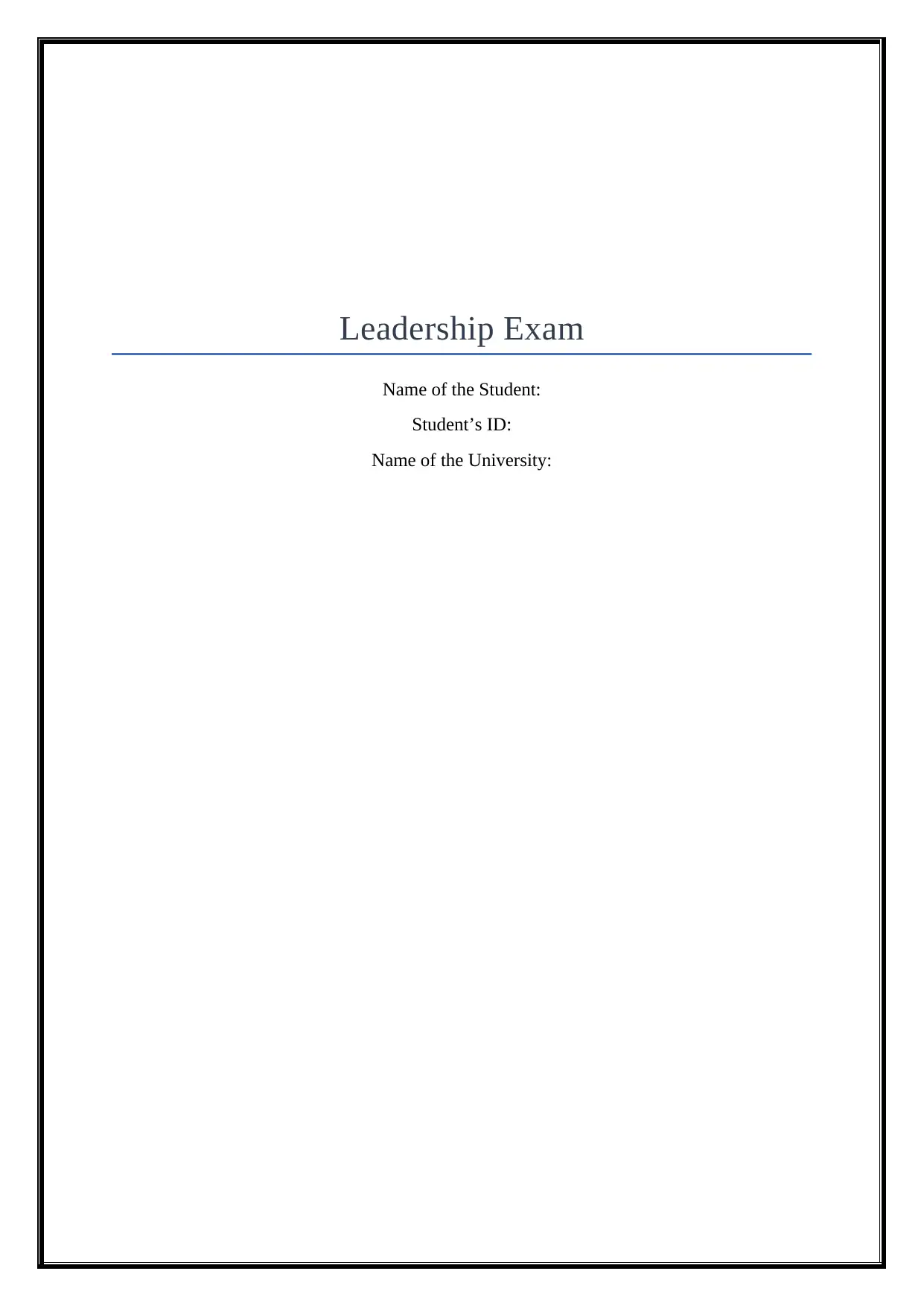
Leadership Exam
Name of the Student:
Student’s ID:
Name of the University:
Name of the Student:
Student’s ID:
Name of the University:
Paraphrase This Document
Need a fresh take? Get an instant paraphrase of this document with our AI Paraphraser
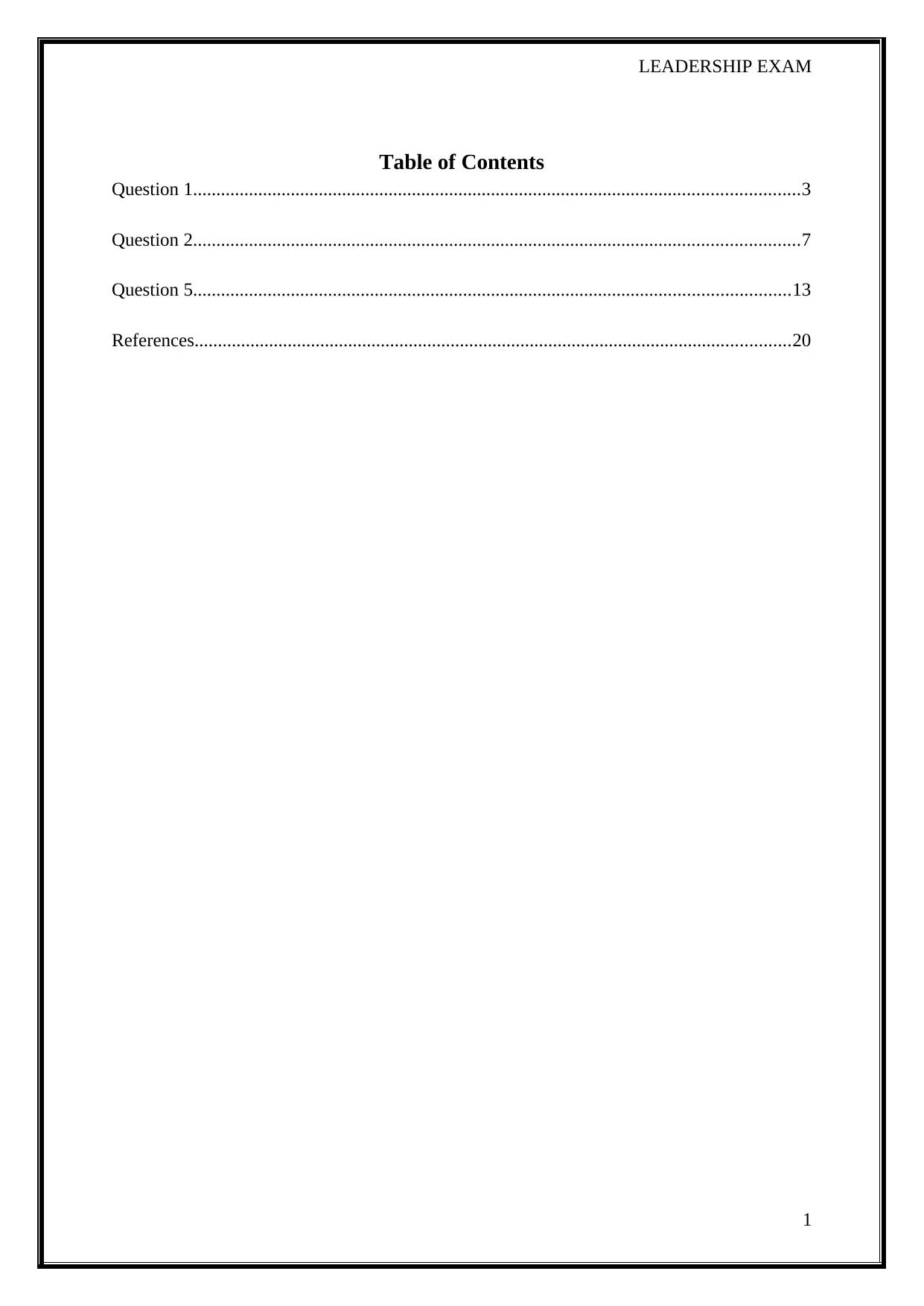
LEADERSHIP EXAM
Table of Contents
Question 1..................................................................................................................................3
Question 2..................................................................................................................................7
Question 5................................................................................................................................13
References................................................................................................................................20
1
Table of Contents
Question 1..................................................................................................................................3
Question 2..................................................................................................................................7
Question 5................................................................................................................................13
References................................................................................................................................20
1
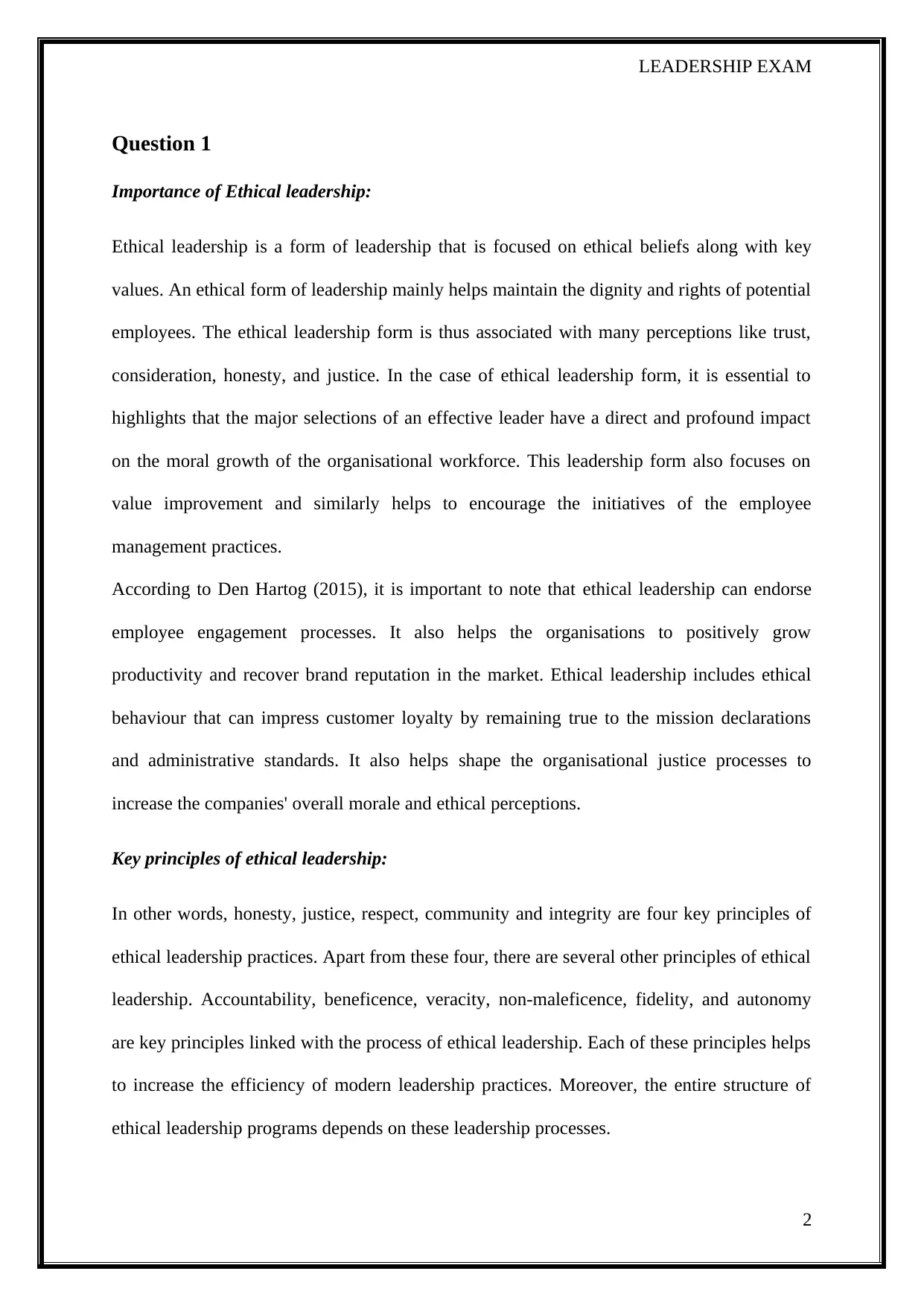
LEADERSHIP EXAM
Question 1
Importance of Ethical leadership:
Ethical leadership is a form of leadership that is focused on ethical beliefs along with key
values. An ethical form of leadership mainly helps maintain the dignity and rights of potential
employees. The ethical leadership form is thus associated with many perceptions like trust,
consideration, honesty, and justice. In the case of ethical leadership form, it is essential to
highlights that the major selections of an effective leader have a direct and profound impact
on the moral growth of the organisational workforce. This leadership form also focuses on
value improvement and similarly helps to encourage the initiatives of the employee
management practices.
According to Den Hartog (2015), it is important to note that ethical leadership can endorse
employee engagement processes. It also helps the organisations to positively grow
productivity and recover brand reputation in the market. Ethical leadership includes ethical
behaviour that can impress customer loyalty by remaining true to the mission declarations
and administrative standards. It also helps shape the organisational justice processes to
increase the companies' overall morale and ethical perceptions.
Key principles of ethical leadership:
In other words, honesty, justice, respect, community and integrity are four key principles of
ethical leadership practices. Apart from these four, there are several other principles of ethical
leadership. Accountability, beneficence, veracity, non-maleficence, fidelity, and autonomy
are key principles linked with the process of ethical leadership. Each of these principles helps
to increase the efficiency of modern leadership practices. Moreover, the entire structure of
ethical leadership programs depends on these leadership processes.
2
Question 1
Importance of Ethical leadership:
Ethical leadership is a form of leadership that is focused on ethical beliefs along with key
values. An ethical form of leadership mainly helps maintain the dignity and rights of potential
employees. The ethical leadership form is thus associated with many perceptions like trust,
consideration, honesty, and justice. In the case of ethical leadership form, it is essential to
highlights that the major selections of an effective leader have a direct and profound impact
on the moral growth of the organisational workforce. This leadership form also focuses on
value improvement and similarly helps to encourage the initiatives of the employee
management practices.
According to Den Hartog (2015), it is important to note that ethical leadership can endorse
employee engagement processes. It also helps the organisations to positively grow
productivity and recover brand reputation in the market. Ethical leadership includes ethical
behaviour that can impress customer loyalty by remaining true to the mission declarations
and administrative standards. It also helps shape the organisational justice processes to
increase the companies' overall morale and ethical perceptions.
Key principles of ethical leadership:
In other words, honesty, justice, respect, community and integrity are four key principles of
ethical leadership practices. Apart from these four, there are several other principles of ethical
leadership. Accountability, beneficence, veracity, non-maleficence, fidelity, and autonomy
are key principles linked with the process of ethical leadership. Each of these principles helps
to increase the efficiency of modern leadership practices. Moreover, the entire structure of
ethical leadership programs depends on these leadership processes.
2
⊘ This is a preview!⊘
Do you want full access?
Subscribe today to unlock all pages.

Trusted by 1+ million students worldwide

LEADERSHIP EXAM
Each of these ethical leadership aspects is mainly helping to inspire the philosophy of the
administrative team's decision-making process by focusing on the key ethics form of the
organisation. It also improves responsibility along with transparency in the case of dealing
with several business choices. In the crisis period, the entire process of ethical leadership
helps to offer an effective, ethical value that helps the leaders of the company cope with the
conflicts by generating the right and relevant solutions.
Impact of the ethical leadership principles:
As per Mihelic, LipicnikandTekavcic (2018), ethical leadership's initial process is associated
with a large number of beneficial activities such as customer loyalty, enhanced recruiting
process, impresses major investors, includes legal performances, positive PR applies, better
partners and vendors along with better-quality morale. Each of these beneficial points helps
to develop the work process of modern business establishments. Ethical leadership helps to
develop the long-term consequences related thinking process. that helps identify the
drawbacks and benefits of the decisions they make in the organisation. Most significantly,
ethical leaders are able to establish high ethics. They are also able to inspire the ethical values
of modern business institutions.
As stated by Alshammari, Almutairi and Thuwaini (2015), the ethical leadership frameworks
mainly help the modern organisations to represent the key requirements to involve the
grounds of psychological authorisation by provides a positive influence to the administrative
performance along with the moral individuality of workforces. Moreover, the ethical
leadership forms influence leadership behaviour to upraise the Leader's performance,
competence, and productivity. The concepts of ethical leadership come with a large number
of capabilities, determination, job gratification, and motivation. These contributions of ethical
leadership affect the entire performance rate of the business establishments, practical
3
Each of these ethical leadership aspects is mainly helping to inspire the philosophy of the
administrative team's decision-making process by focusing on the key ethics form of the
organisation. It also improves responsibility along with transparency in the case of dealing
with several business choices. In the crisis period, the entire process of ethical leadership
helps to offer an effective, ethical value that helps the leaders of the company cope with the
conflicts by generating the right and relevant solutions.
Impact of the ethical leadership principles:
As per Mihelic, LipicnikandTekavcic (2018), ethical leadership's initial process is associated
with a large number of beneficial activities such as customer loyalty, enhanced recruiting
process, impresses major investors, includes legal performances, positive PR applies, better
partners and vendors along with better-quality morale. Each of these beneficial points helps
to develop the work process of modern business establishments. Ethical leadership helps to
develop the long-term consequences related thinking process. that helps identify the
drawbacks and benefits of the decisions they make in the organisation. Most significantly,
ethical leaders are able to establish high ethics. They are also able to inspire the ethical values
of modern business institutions.
As stated by Alshammari, Almutairi and Thuwaini (2015), the ethical leadership frameworks
mainly help the modern organisations to represent the key requirements to involve the
grounds of psychological authorisation by provides a positive influence to the administrative
performance along with the moral individuality of workforces. Moreover, the ethical
leadership forms influence leadership behaviour to upraise the Leader's performance,
competence, and productivity. The concepts of ethical leadership come with a large number
of capabilities, determination, job gratification, and motivation. These contributions of ethical
leadership affect the entire performance rate of the business establishments, practical
3
Paraphrase This Document
Need a fresh take? Get an instant paraphrase of this document with our AI Paraphraser
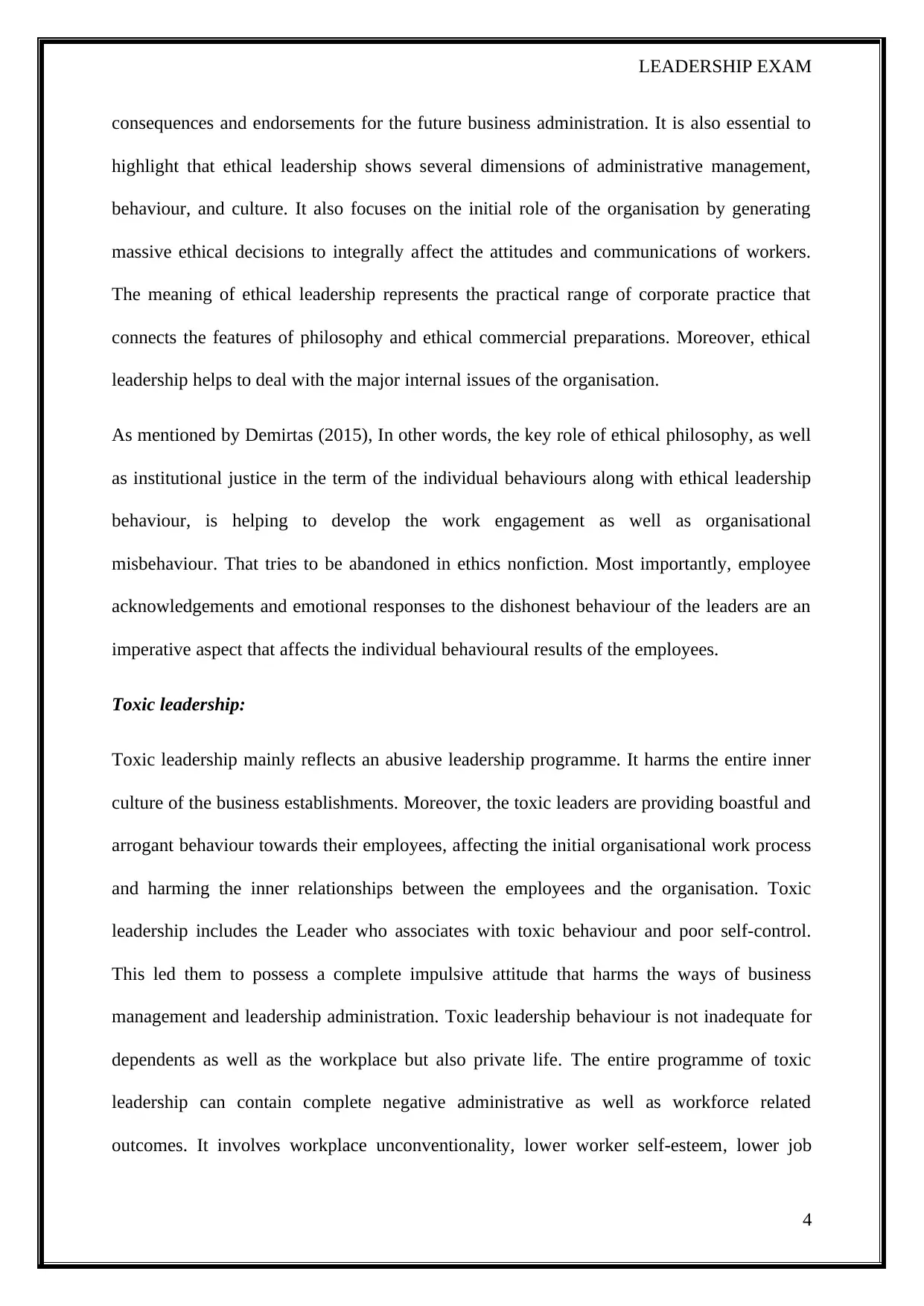
LEADERSHIP EXAM
consequences and endorsements for the future business administration. It is also essential to
highlight that ethical leadership shows several dimensions of administrative management,
behaviour, and culture. It also focuses on the initial role of the organisation by generating
massive ethical decisions to integrally affect the attitudes and communications of workers.
The meaning of ethical leadership represents the practical range of corporate practice that
connects the features of philosophy and ethical commercial preparations. Moreover, ethical
leadership helps to deal with the major internal issues of the organisation.
As mentioned by Demirtas (2015), In other words, the key role of ethical philosophy, as well
as institutional justice in the term of the individual behaviours along with ethical leadership
behaviour, is helping to develop the work engagement as well as organisational
misbehaviour. That tries to be abandoned in ethics nonfiction. Most importantly, employee
acknowledgements and emotional responses to the dishonest behaviour of the leaders are an
imperative aspect that affects the individual behavioural results of the employees.
Toxic leadership:
Toxic leadership mainly reflects an abusive leadership programme. It harms the entire inner
culture of the business establishments. Moreover, the toxic leaders are providing boastful and
arrogant behaviour towards their employees, affecting the initial organisational work process
and harming the inner relationships between the employees and the organisation. Toxic
leadership includes the Leader who associates with toxic behaviour and poor self-control.
This led them to possess a complete impulsive attitude that harms the ways of business
management and leadership administration. Toxic leadership behaviour is not inadequate for
dependents as well as the workplace but also private life. The entire programme of toxic
leadership can contain complete negative administrative as well as workforce related
outcomes. It involves workplace unconventionality, lower worker self-esteem, lower job
4
consequences and endorsements for the future business administration. It is also essential to
highlight that ethical leadership shows several dimensions of administrative management,
behaviour, and culture. It also focuses on the initial role of the organisation by generating
massive ethical decisions to integrally affect the attitudes and communications of workers.
The meaning of ethical leadership represents the practical range of corporate practice that
connects the features of philosophy and ethical commercial preparations. Moreover, ethical
leadership helps to deal with the major internal issues of the organisation.
As mentioned by Demirtas (2015), In other words, the key role of ethical philosophy, as well
as institutional justice in the term of the individual behaviours along with ethical leadership
behaviour, is helping to develop the work engagement as well as organisational
misbehaviour. That tries to be abandoned in ethics nonfiction. Most importantly, employee
acknowledgements and emotional responses to the dishonest behaviour of the leaders are an
imperative aspect that affects the individual behavioural results of the employees.
Toxic leadership:
Toxic leadership mainly reflects an abusive leadership programme. It harms the entire inner
culture of the business establishments. Moreover, the toxic leaders are providing boastful and
arrogant behaviour towards their employees, affecting the initial organisational work process
and harming the inner relationships between the employees and the organisation. Toxic
leadership includes the Leader who associates with toxic behaviour and poor self-control.
This led them to possess a complete impulsive attitude that harms the ways of business
management and leadership administration. Toxic leadership behaviour is not inadequate for
dependents as well as the workplace but also private life. The entire programme of toxic
leadership can contain complete negative administrative as well as workforce related
outcomes. It involves workplace unconventionality, lower worker self-esteem, lower job
4
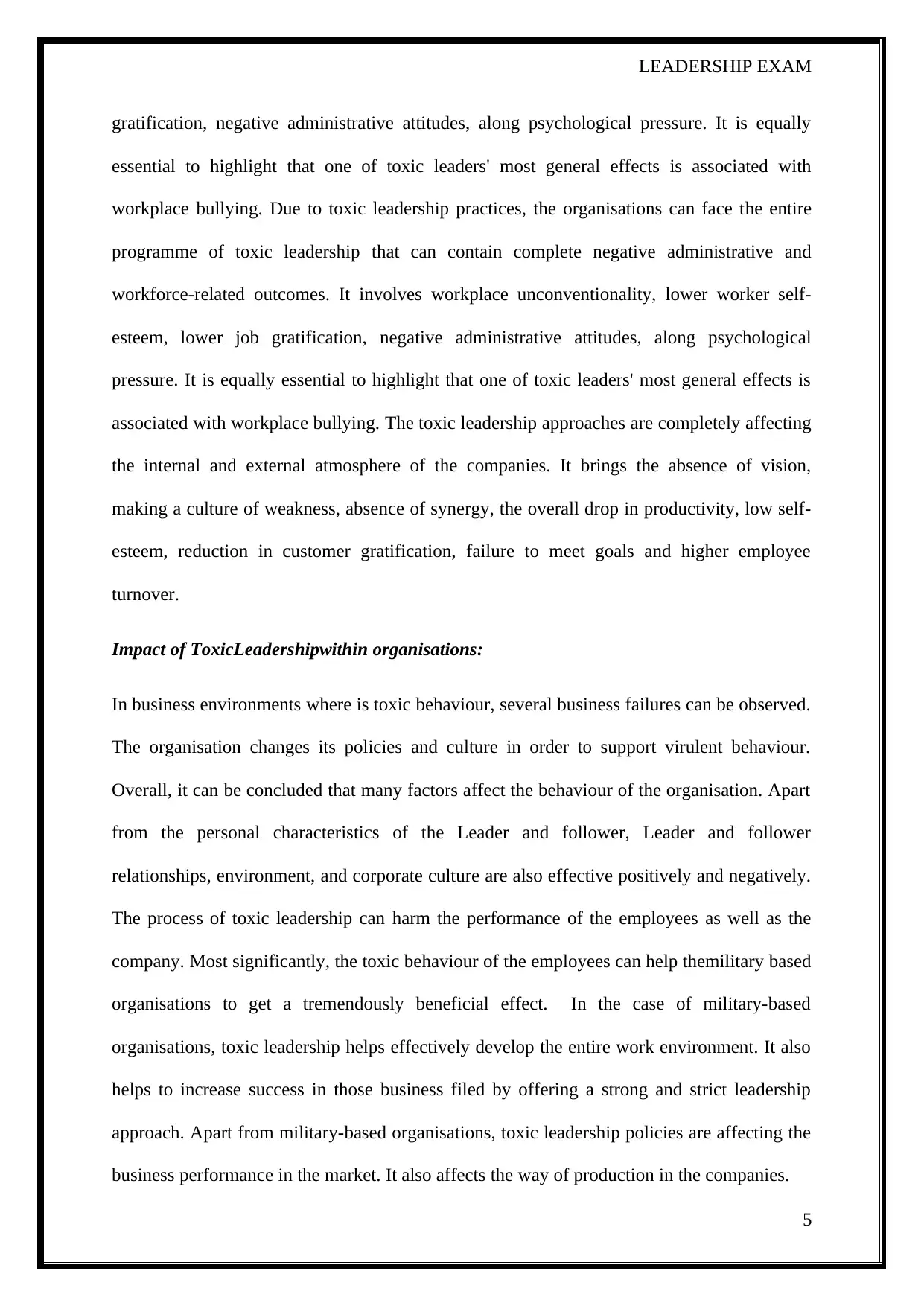
LEADERSHIP EXAM
gratification, negative administrative attitudes, along psychological pressure. It is equally
essential to highlight that one of toxic leaders' most general effects is associated with
workplace bullying. Due to toxic leadership practices, the organisations can face the entire
programme of toxic leadership that can contain complete negative administrative and
workforce-related outcomes. It involves workplace unconventionality, lower worker self-
esteem, lower job gratification, negative administrative attitudes, along psychological
pressure. It is equally essential to highlight that one of toxic leaders' most general effects is
associated with workplace bullying. The toxic leadership approaches are completely affecting
the internal and external atmosphere of the companies. It brings the absence of vision,
making a culture of weakness, absence of synergy, the overall drop in productivity, low self-
esteem, reduction in customer gratification, failure to meet goals and higher employee
turnover.
Impact of ToxicLeadershipwithin organisations:
In business environments where is toxic behaviour, several business failures can be observed.
The organisation changes its policies and culture in order to support virulent behaviour.
Overall, it can be concluded that many factors affect the behaviour of the organisation. Apart
from the personal characteristics of the Leader and follower, Leader and follower
relationships, environment, and corporate culture are also effective positively and negatively.
The process of toxic leadership can harm the performance of the employees as well as the
company. Most significantly, the toxic behaviour of the employees can help themilitary based
organisations to get a tremendously beneficial effect. In the case of military-based
organisations, toxic leadership helps effectively develop the entire work environment. It also
helps to increase success in those business filed by offering a strong and strict leadership
approach. Apart from military-based organisations, toxic leadership policies are affecting the
business performance in the market. It also affects the way of production in the companies.
5
gratification, negative administrative attitudes, along psychological pressure. It is equally
essential to highlight that one of toxic leaders' most general effects is associated with
workplace bullying. Due to toxic leadership practices, the organisations can face the entire
programme of toxic leadership that can contain complete negative administrative and
workforce-related outcomes. It involves workplace unconventionality, lower worker self-
esteem, lower job gratification, negative administrative attitudes, along psychological
pressure. It is equally essential to highlight that one of toxic leaders' most general effects is
associated with workplace bullying. The toxic leadership approaches are completely affecting
the internal and external atmosphere of the companies. It brings the absence of vision,
making a culture of weakness, absence of synergy, the overall drop in productivity, low self-
esteem, reduction in customer gratification, failure to meet goals and higher employee
turnover.
Impact of ToxicLeadershipwithin organisations:
In business environments where is toxic behaviour, several business failures can be observed.
The organisation changes its policies and culture in order to support virulent behaviour.
Overall, it can be concluded that many factors affect the behaviour of the organisation. Apart
from the personal characteristics of the Leader and follower, Leader and follower
relationships, environment, and corporate culture are also effective positively and negatively.
The process of toxic leadership can harm the performance of the employees as well as the
company. Most significantly, the toxic behaviour of the employees can help themilitary based
organisations to get a tremendously beneficial effect. In the case of military-based
organisations, toxic leadership helps effectively develop the entire work environment. It also
helps to increase success in those business filed by offering a strong and strict leadership
approach. Apart from military-based organisations, toxic leadership policies are affecting the
business performance in the market. It also affects the way of production in the companies.
5
⊘ This is a preview!⊘
Do you want full access?
Subscribe today to unlock all pages.

Trusted by 1+ million students worldwide
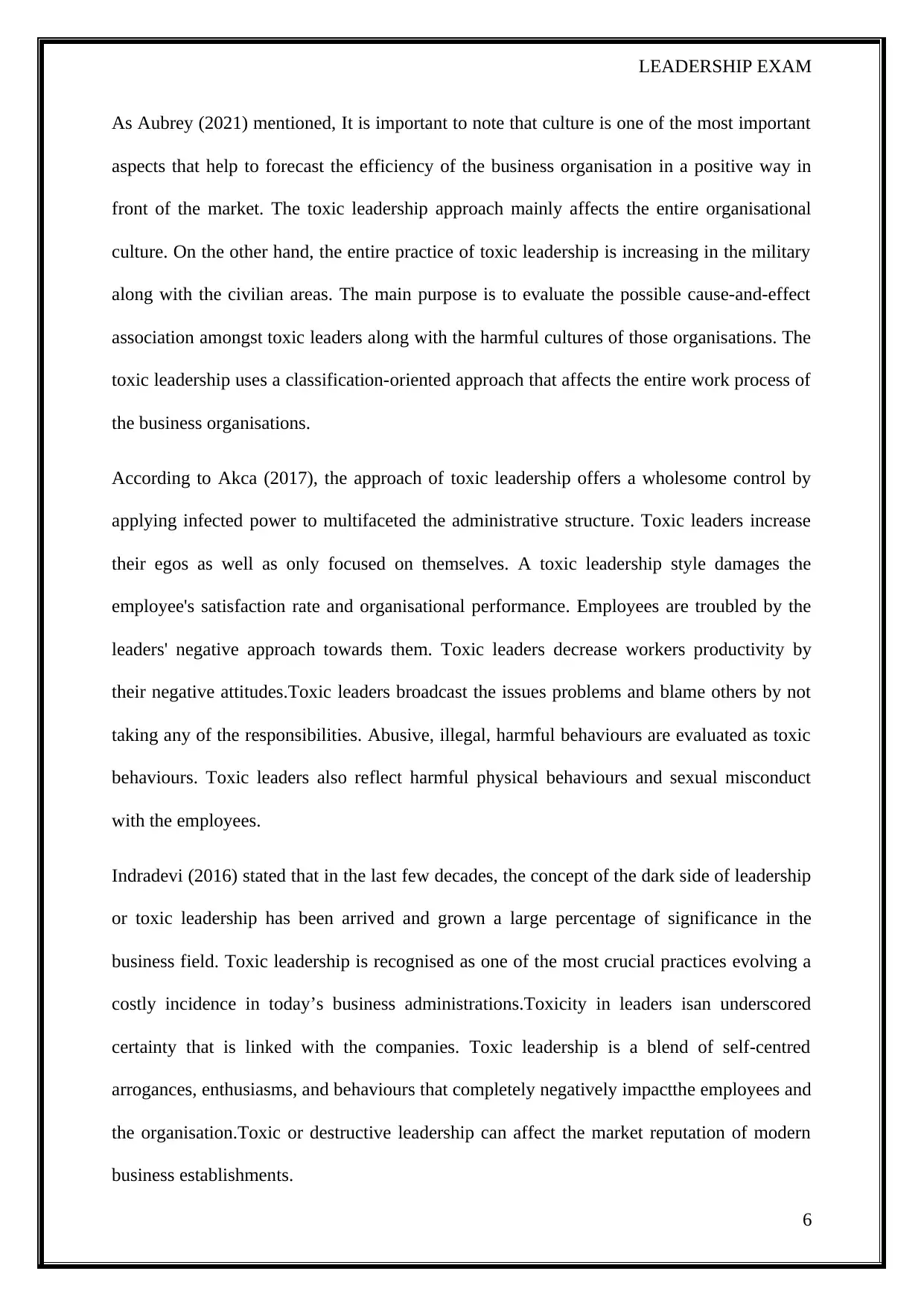
LEADERSHIP EXAM
As Aubrey (2021) mentioned, It is important to note that culture is one of the most important
aspects that help to forecast the efficiency of the business organisation in a positive way in
front of the market. The toxic leadership approach mainly affects the entire organisational
culture. On the other hand, the entire practice of toxic leadership is increasing in the military
along with the civilian areas. The main purpose is to evaluate the possible cause-and-effect
association amongst toxic leaders along with the harmful cultures of those organisations. The
toxic leadership uses a classification-oriented approach that affects the entire work process of
the business organisations.
According to Akca (2017), the approach of toxic leadership offers a wholesome control by
applying infected power to multifaceted the administrative structure. Toxic leaders increase
their egos as well as only focused on themselves. A toxic leadership style damages the
employee's satisfaction rate and organisational performance. Employees are troubled by the
leaders' negative approach towards them. Toxic leaders decrease workers productivity by
their negative attitudes.Toxic leaders broadcast the issues problems and blame others by not
taking any of the responsibilities. Abusive, illegal, harmful behaviours are evaluated as toxic
behaviours. Toxic leaders also reflect harmful physical behaviours and sexual misconduct
with the employees.
Indradevi (2016) stated that in the last few decades, the concept of the dark side of leadership
or toxic leadership has been arrived and grown a large percentage of significance in the
business field. Toxic leadership is recognised as one of the most crucial practices evolving a
costly incidence in today’s business administrations.Toxicity in leaders isan underscored
certainty that is linked with the companies. Toxic leadership is a blend of self-centred
arrogances, enthusiasms, and behaviours that completely negatively impactthe employees and
the organisation.Toxic or destructive leadership can affect the market reputation of modern
business establishments.
6
As Aubrey (2021) mentioned, It is important to note that culture is one of the most important
aspects that help to forecast the efficiency of the business organisation in a positive way in
front of the market. The toxic leadership approach mainly affects the entire organisational
culture. On the other hand, the entire practice of toxic leadership is increasing in the military
along with the civilian areas. The main purpose is to evaluate the possible cause-and-effect
association amongst toxic leaders along with the harmful cultures of those organisations. The
toxic leadership uses a classification-oriented approach that affects the entire work process of
the business organisations.
According to Akca (2017), the approach of toxic leadership offers a wholesome control by
applying infected power to multifaceted the administrative structure. Toxic leaders increase
their egos as well as only focused on themselves. A toxic leadership style damages the
employee's satisfaction rate and organisational performance. Employees are troubled by the
leaders' negative approach towards them. Toxic leaders decrease workers productivity by
their negative attitudes.Toxic leaders broadcast the issues problems and blame others by not
taking any of the responsibilities. Abusive, illegal, harmful behaviours are evaluated as toxic
behaviours. Toxic leaders also reflect harmful physical behaviours and sexual misconduct
with the employees.
Indradevi (2016) stated that in the last few decades, the concept of the dark side of leadership
or toxic leadership has been arrived and grown a large percentage of significance in the
business field. Toxic leadership is recognised as one of the most crucial practices evolving a
costly incidence in today’s business administrations.Toxicity in leaders isan underscored
certainty that is linked with the companies. Toxic leadership is a blend of self-centred
arrogances, enthusiasms, and behaviours that completely negatively impactthe employees and
the organisation.Toxic or destructive leadership can affect the market reputation of modern
business establishments.
6
Paraphrase This Document
Need a fresh take? Get an instant paraphrase of this document with our AI Paraphraser
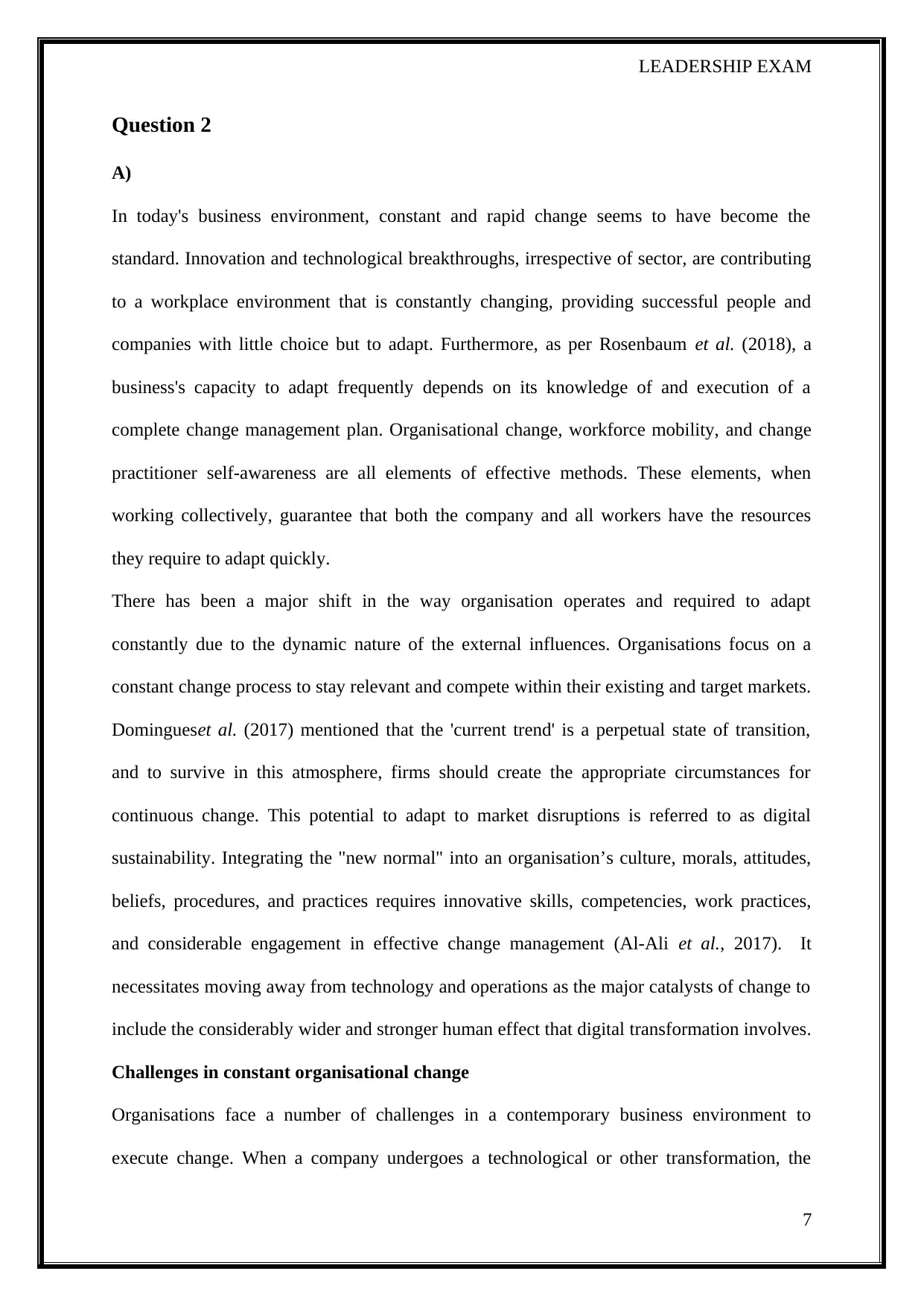
LEADERSHIP EXAM
Question 2
A)
In today's business environment, constant and rapid change seems to have become the
standard. Innovation and technological breakthroughs, irrespective of sector, are contributing
to a workplace environment that is constantly changing, providing successful people and
companies with little choice but to adapt. Furthermore, as per Rosenbaum et al. (2018), a
business's capacity to adapt frequently depends on its knowledge of and execution of a
complete change management plan. Organisational change, workforce mobility, and change
practitioner self-awareness are all elements of effective methods. These elements, when
working collectively, guarantee that both the company and all workers have the resources
they require to adapt quickly.
There has been a major shift in the way organisation operates and required to adapt
constantly due to the dynamic nature of the external influences. Organisations focus on a
constant change process to stay relevant and compete within their existing and target markets.
Domingueset al. (2017) mentioned that the 'current trend' is a perpetual state of transition,
and to survive in this atmosphere, firms should create the appropriate circumstances for
continuous change. This potential to adapt to market disruptions is referred to as digital
sustainability. Integrating the "new normal" into an organisation’s culture, morals, attitudes,
beliefs, procedures, and practices requires innovative skills, competencies, work practices,
and considerable engagement in effective change management (Al-Ali et al., 2017). It
necessitates moving away from technology and operations as the major catalysts of change to
include the considerably wider and stronger human effect that digital transformation involves.
Challenges in constant organisational change
Organisations face a number of challenges in a contemporary business environment to
execute change. When a company undergoes a technological or other transformation, the
7
Question 2
A)
In today's business environment, constant and rapid change seems to have become the
standard. Innovation and technological breakthroughs, irrespective of sector, are contributing
to a workplace environment that is constantly changing, providing successful people and
companies with little choice but to adapt. Furthermore, as per Rosenbaum et al. (2018), a
business's capacity to adapt frequently depends on its knowledge of and execution of a
complete change management plan. Organisational change, workforce mobility, and change
practitioner self-awareness are all elements of effective methods. These elements, when
working collectively, guarantee that both the company and all workers have the resources
they require to adapt quickly.
There has been a major shift in the way organisation operates and required to adapt
constantly due to the dynamic nature of the external influences. Organisations focus on a
constant change process to stay relevant and compete within their existing and target markets.
Domingueset al. (2017) mentioned that the 'current trend' is a perpetual state of transition,
and to survive in this atmosphere, firms should create the appropriate circumstances for
continuous change. This potential to adapt to market disruptions is referred to as digital
sustainability. Integrating the "new normal" into an organisation’s culture, morals, attitudes,
beliefs, procedures, and practices requires innovative skills, competencies, work practices,
and considerable engagement in effective change management (Al-Ali et al., 2017). It
necessitates moving away from technology and operations as the major catalysts of change to
include the considerably wider and stronger human effect that digital transformation involves.
Challenges in constant organisational change
Organisations face a number of challenges in a contemporary business environment to
execute change. When a company undergoes a technological or other transformation, the
7
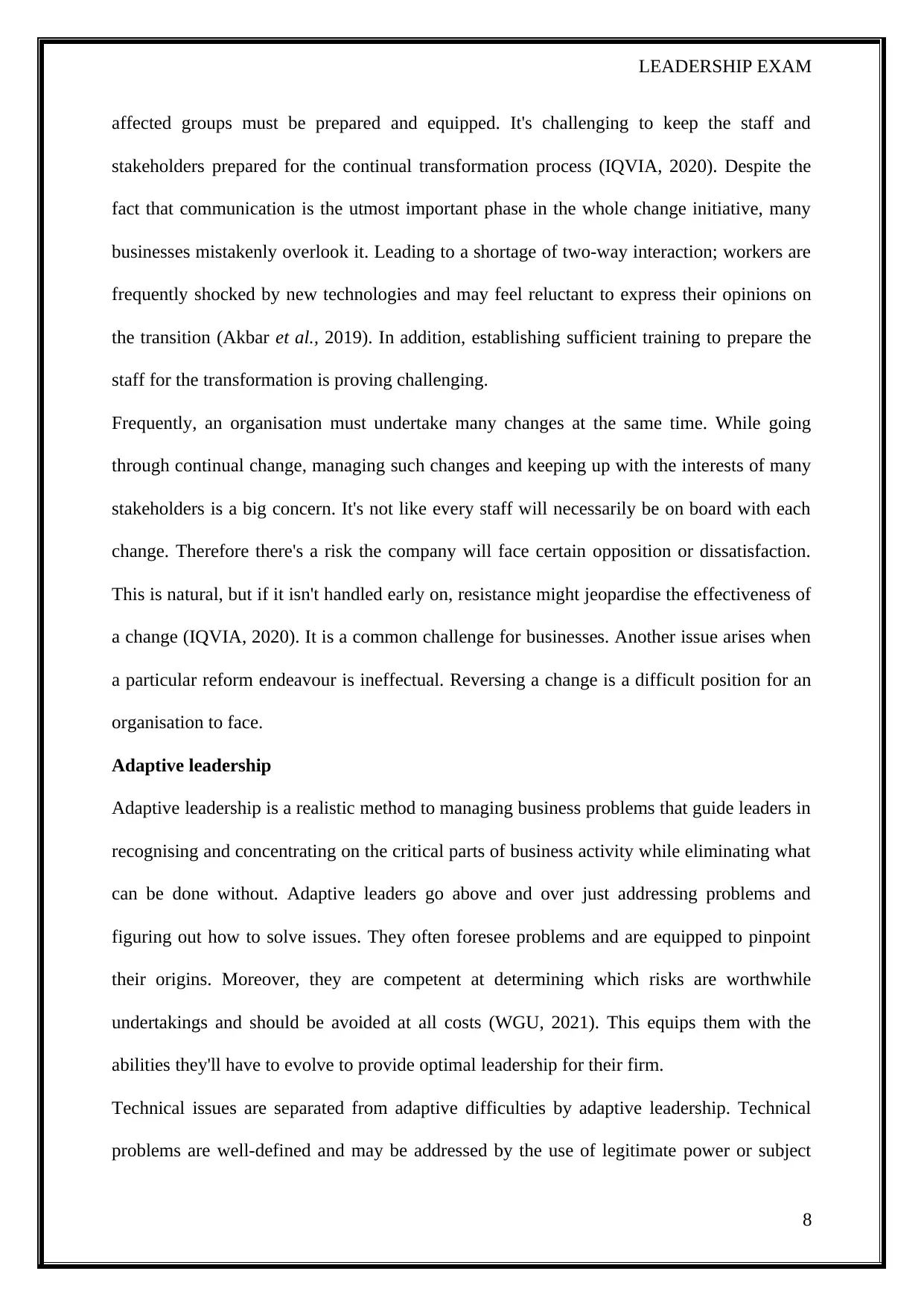
LEADERSHIP EXAM
affected groups must be prepared and equipped. It's challenging to keep the staff and
stakeholders prepared for the continual transformation process (IQVIA, 2020). Despite the
fact that communication is the utmost important phase in the whole change initiative, many
businesses mistakenly overlook it. Leading to a shortage of two-way interaction; workers are
frequently shocked by new technologies and may feel reluctant to express their opinions on
the transition (Akbar et al., 2019). In addition, establishing sufficient training to prepare the
staff for the transformation is proving challenging.
Frequently, an organisation must undertake many changes at the same time. While going
through continual change, managing such changes and keeping up with the interests of many
stakeholders is a big concern. It's not like every staff will necessarily be on board with each
change. Therefore there's a risk the company will face certain opposition or dissatisfaction.
This is natural, but if it isn't handled early on, resistance might jeopardise the effectiveness of
a change (IQVIA, 2020). It is a common challenge for businesses. Another issue arises when
a particular reform endeavour is ineffectual. Reversing a change is a difficult position for an
organisation to face.
Adaptive leadership
Adaptive leadership is a realistic method to managing business problems that guide leaders in
recognising and concentrating on the critical parts of business activity while eliminating what
can be done without. Adaptive leaders go above and over just addressing problems and
figuring out how to solve issues. They often foresee problems and are equipped to pinpoint
their origins. Moreover, they are competent at determining which risks are worthwhile
undertakings and should be avoided at all costs (WGU, 2021). This equips them with the
abilities they'll have to evolve to provide optimal leadership for their firm.
Technical issues are separated from adaptive difficulties by adaptive leadership. Technical
problems are well-defined and may be addressed by the use of legitimate power or subject
8
affected groups must be prepared and equipped. It's challenging to keep the staff and
stakeholders prepared for the continual transformation process (IQVIA, 2020). Despite the
fact that communication is the utmost important phase in the whole change initiative, many
businesses mistakenly overlook it. Leading to a shortage of two-way interaction; workers are
frequently shocked by new technologies and may feel reluctant to express their opinions on
the transition (Akbar et al., 2019). In addition, establishing sufficient training to prepare the
staff for the transformation is proving challenging.
Frequently, an organisation must undertake many changes at the same time. While going
through continual change, managing such changes and keeping up with the interests of many
stakeholders is a big concern. It's not like every staff will necessarily be on board with each
change. Therefore there's a risk the company will face certain opposition or dissatisfaction.
This is natural, but if it isn't handled early on, resistance might jeopardise the effectiveness of
a change (IQVIA, 2020). It is a common challenge for businesses. Another issue arises when
a particular reform endeavour is ineffectual. Reversing a change is a difficult position for an
organisation to face.
Adaptive leadership
Adaptive leadership is a realistic method to managing business problems that guide leaders in
recognising and concentrating on the critical parts of business activity while eliminating what
can be done without. Adaptive leaders go above and over just addressing problems and
figuring out how to solve issues. They often foresee problems and are equipped to pinpoint
their origins. Moreover, they are competent at determining which risks are worthwhile
undertakings and should be avoided at all costs (WGU, 2021). This equips them with the
abilities they'll have to evolve to provide optimal leadership for their firm.
Technical issues are separated from adaptive difficulties by adaptive leadership. Technical
problems are well-defined and may be addressed by the use of legitimate power or subject
8
⊘ This is a preview!⊘
Do you want full access?
Subscribe today to unlock all pages.

Trusted by 1+ million students worldwide

LEADERSHIP EXAM
expertise, such as writing a contract by a competent and skilled attorney. Adaptive problems
contain ambiguous definitions and remedies, and they could only be handled via broad
stakeholder interaction and involvement (CFI, 2021). It would have been an adaptive problem
to figure out how to offshore a firm's legal activity without removing important workers.
Priorities, attitudes, habits, and affiliations of stakeholders must be handled and, in certain
cases, adjusted in order to overcome the problems related to organisational change.
Principles of adaptive leadership
Like any other leadership approach, the adaptive approach does have its series of concepts,
each of which is critical to properly utilising adaptive leadership.
Emotional intelligence
Adaptive leaders are aware of their followers' emotions. They understand that change is
difficult. Since empathy fosters trust, it also has the extra benefit of increasing morale all
across the business (ANSOG, 2017). A staff that feels acknowledged and encouraged is far
more willing to make an effort required to help the firm accomplish its objectives.
Organisational justice
Establishing an honest culture has been another important concept of adaptive leadership.
Adaptive leaders are aware of the appropriate policies for implementing changes (CFI, 2021).
They also recognise how to introduce such modifications in the most effective way possible
so that individuals accept them. Adaptive leaders are prepared to accept others' viewpoints,
reassuring them that their opinions are appreciated and respected.
Development
According to Bagwell (2020), Adaptive leaders relish the opportunity to explore new ideas,
particularly if it aids the company’s success and ability to respond to change. They have a
proclivity for experimentation and innovation, but they're not scared of failure in the
9
expertise, such as writing a contract by a competent and skilled attorney. Adaptive problems
contain ambiguous definitions and remedies, and they could only be handled via broad
stakeholder interaction and involvement (CFI, 2021). It would have been an adaptive problem
to figure out how to offshore a firm's legal activity without removing important workers.
Priorities, attitudes, habits, and affiliations of stakeholders must be handled and, in certain
cases, adjusted in order to overcome the problems related to organisational change.
Principles of adaptive leadership
Like any other leadership approach, the adaptive approach does have its series of concepts,
each of which is critical to properly utilising adaptive leadership.
Emotional intelligence
Adaptive leaders are aware of their followers' emotions. They understand that change is
difficult. Since empathy fosters trust, it also has the extra benefit of increasing morale all
across the business (ANSOG, 2017). A staff that feels acknowledged and encouraged is far
more willing to make an effort required to help the firm accomplish its objectives.
Organisational justice
Establishing an honest culture has been another important concept of adaptive leadership.
Adaptive leaders are aware of the appropriate policies for implementing changes (CFI, 2021).
They also recognise how to introduce such modifications in the most effective way possible
so that individuals accept them. Adaptive leaders are prepared to accept others' viewpoints,
reassuring them that their opinions are appreciated and respected.
Development
According to Bagwell (2020), Adaptive leaders relish the opportunity to explore new ideas,
particularly if it aids the company’s success and ability to respond to change. They have a
proclivity for experimentation and innovation, but they're not scared of failure in the
9
Paraphrase This Document
Need a fresh take? Get an instant paraphrase of this document with our AI Paraphraser
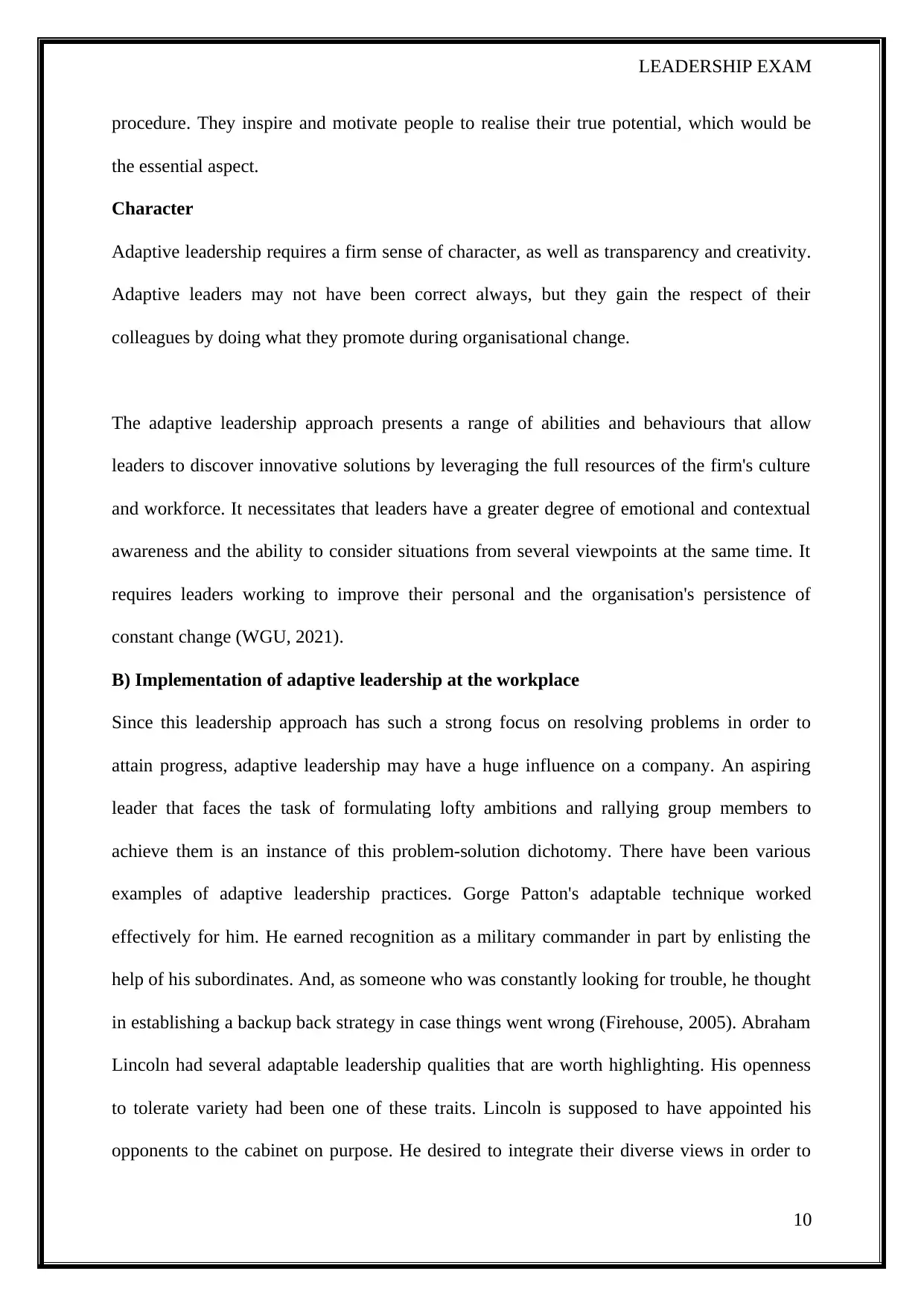
LEADERSHIP EXAM
procedure. They inspire and motivate people to realise their true potential, which would be
the essential aspect.
Character
Adaptive leadership requires a firm sense of character, as well as transparency and creativity.
Adaptive leaders may not have been correct always, but they gain the respect of their
colleagues by doing what they promote during organisational change.
The adaptive leadership approach presents a range of abilities and behaviours that allow
leaders to discover innovative solutions by leveraging the full resources of the firm's culture
and workforce. It necessitates that leaders have a greater degree of emotional and contextual
awareness and the ability to consider situations from several viewpoints at the same time. It
requires leaders working to improve their personal and the organisation's persistence of
constant change (WGU, 2021).
B) Implementation of adaptive leadership at the workplace
Since this leadership approach has such a strong focus on resolving problems in order to
attain progress, adaptive leadership may have a huge influence on a company. An aspiring
leader that faces the task of formulating lofty ambitions and rallying group members to
achieve them is an instance of this problem-solution dichotomy. There have been various
examples of adaptive leadership practices. Gorge Patton's adaptable technique worked
effectively for him. He earned recognition as a military commander in part by enlisting the
help of his subordinates. And, as someone who was constantly looking for trouble, he thought
in establishing a backup back strategy in case things went wrong (Firehouse, 2005). Abraham
Lincoln had several adaptable leadership qualities that are worth highlighting. His openness
to tolerate variety had been one of these traits. Lincoln is supposed to have appointed his
opponents to the cabinet on purpose. He desired to integrate their diverse views in order to
10
procedure. They inspire and motivate people to realise their true potential, which would be
the essential aspect.
Character
Adaptive leadership requires a firm sense of character, as well as transparency and creativity.
Adaptive leaders may not have been correct always, but they gain the respect of their
colleagues by doing what they promote during organisational change.
The adaptive leadership approach presents a range of abilities and behaviours that allow
leaders to discover innovative solutions by leveraging the full resources of the firm's culture
and workforce. It necessitates that leaders have a greater degree of emotional and contextual
awareness and the ability to consider situations from several viewpoints at the same time. It
requires leaders working to improve their personal and the organisation's persistence of
constant change (WGU, 2021).
B) Implementation of adaptive leadership at the workplace
Since this leadership approach has such a strong focus on resolving problems in order to
attain progress, adaptive leadership may have a huge influence on a company. An aspiring
leader that faces the task of formulating lofty ambitions and rallying group members to
achieve them is an instance of this problem-solution dichotomy. There have been various
examples of adaptive leadership practices. Gorge Patton's adaptable technique worked
effectively for him. He earned recognition as a military commander in part by enlisting the
help of his subordinates. And, as someone who was constantly looking for trouble, he thought
in establishing a backup back strategy in case things went wrong (Firehouse, 2005). Abraham
Lincoln had several adaptable leadership qualities that are worth highlighting. His openness
to tolerate variety had been one of these traits. Lincoln is supposed to have appointed his
opponents to the cabinet on purpose. He desired to integrate their diverse views in order to
10
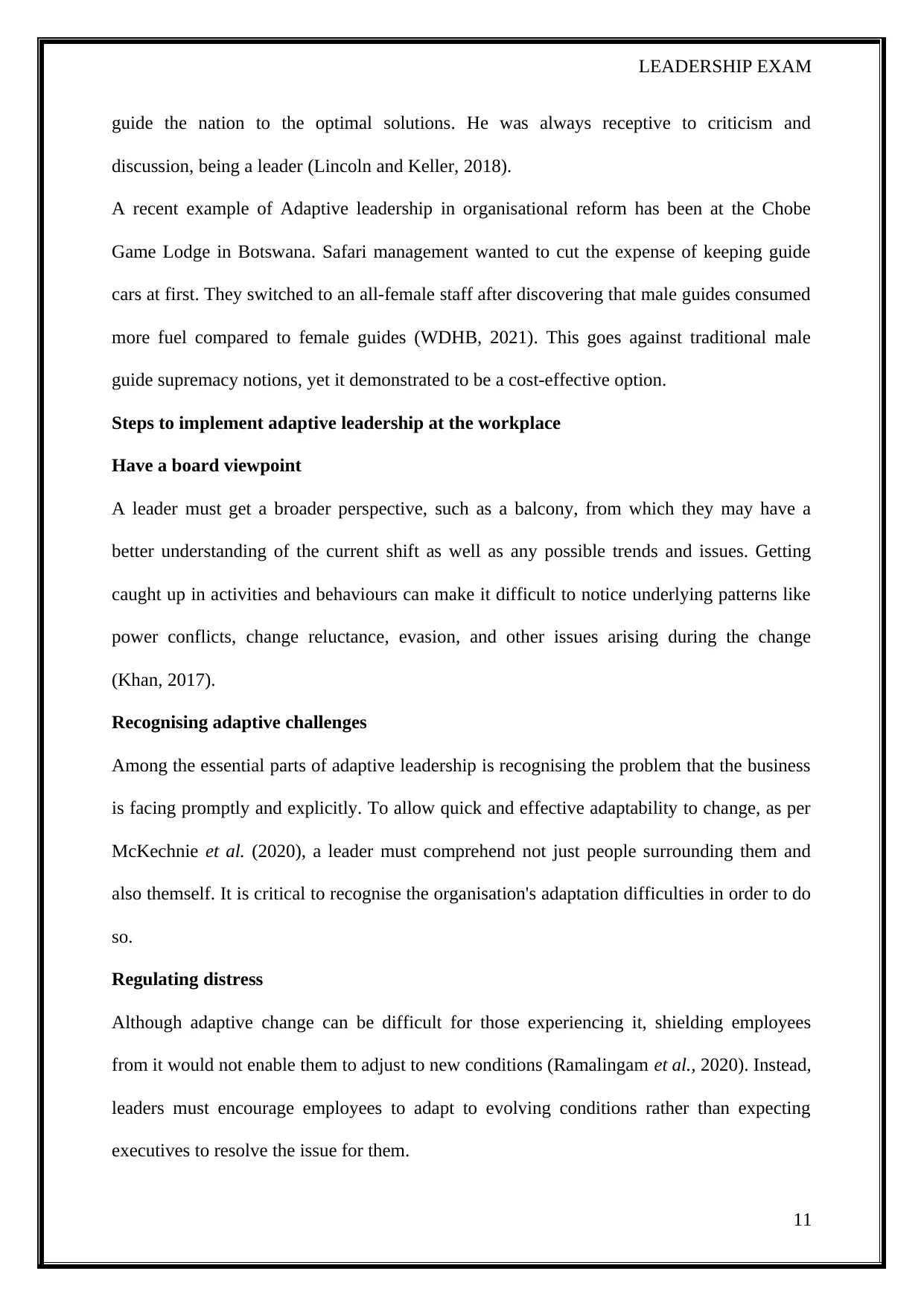
LEADERSHIP EXAM
guide the nation to the optimal solutions. He was always receptive to criticism and
discussion, being a leader (Lincoln and Keller, 2018).
A recent example of Adaptive leadership in organisational reform has been at the Chobe
Game Lodge in Botswana. Safari management wanted to cut the expense of keeping guide
cars at first. They switched to an all-female staff after discovering that male guides consumed
more fuel compared to female guides (WDHB, 2021). This goes against traditional male
guide supremacy notions, yet it demonstrated to be a cost-effective option.
Steps to implement adaptive leadership at the workplace
Have a board viewpoint
A leader must get a broader perspective, such as a balcony, from which they may have a
better understanding of the current shift as well as any possible trends and issues. Getting
caught up in activities and behaviours can make it difficult to notice underlying patterns like
power conflicts, change reluctance, evasion, and other issues arising during the change
(Khan, 2017).
Recognising adaptive challenges
Among the essential parts of adaptive leadership is recognising the problem that the business
is facing promptly and explicitly. To allow quick and effective adaptability to change, as per
McKechnie et al. (2020), a leader must comprehend not just people surrounding them and
also themself. It is critical to recognise the organisation's adaptation difficulties in order to do
so.
Regulating distress
Although adaptive change can be difficult for those experiencing it, shielding employees
from it would not enable them to adjust to new conditions (Ramalingam et al., 2020). Instead,
leaders must encourage employees to adapt to evolving conditions rather than expecting
executives to resolve the issue for them.
11
guide the nation to the optimal solutions. He was always receptive to criticism and
discussion, being a leader (Lincoln and Keller, 2018).
A recent example of Adaptive leadership in organisational reform has been at the Chobe
Game Lodge in Botswana. Safari management wanted to cut the expense of keeping guide
cars at first. They switched to an all-female staff after discovering that male guides consumed
more fuel compared to female guides (WDHB, 2021). This goes against traditional male
guide supremacy notions, yet it demonstrated to be a cost-effective option.
Steps to implement adaptive leadership at the workplace
Have a board viewpoint
A leader must get a broader perspective, such as a balcony, from which they may have a
better understanding of the current shift as well as any possible trends and issues. Getting
caught up in activities and behaviours can make it difficult to notice underlying patterns like
power conflicts, change reluctance, evasion, and other issues arising during the change
(Khan, 2017).
Recognising adaptive challenges
Among the essential parts of adaptive leadership is recognising the problem that the business
is facing promptly and explicitly. To allow quick and effective adaptability to change, as per
McKechnie et al. (2020), a leader must comprehend not just people surrounding them and
also themself. It is critical to recognise the organisation's adaptation difficulties in order to do
so.
Regulating distress
Although adaptive change can be difficult for those experiencing it, shielding employees
from it would not enable them to adjust to new conditions (Ramalingam et al., 2020). Instead,
leaders must encourage employees to adapt to evolving conditions rather than expecting
executives to resolve the issue for them.
11
⊘ This is a preview!⊘
Do you want full access?
Subscribe today to unlock all pages.

Trusted by 1+ million students worldwide
1 out of 23
Related Documents
Your All-in-One AI-Powered Toolkit for Academic Success.
+13062052269
info@desklib.com
Available 24*7 on WhatsApp / Email
![[object Object]](/_next/static/media/star-bottom.7253800d.svg)
Unlock your academic potential
Copyright © 2020–2025 A2Z Services. All Rights Reserved. Developed and managed by ZUCOL.





